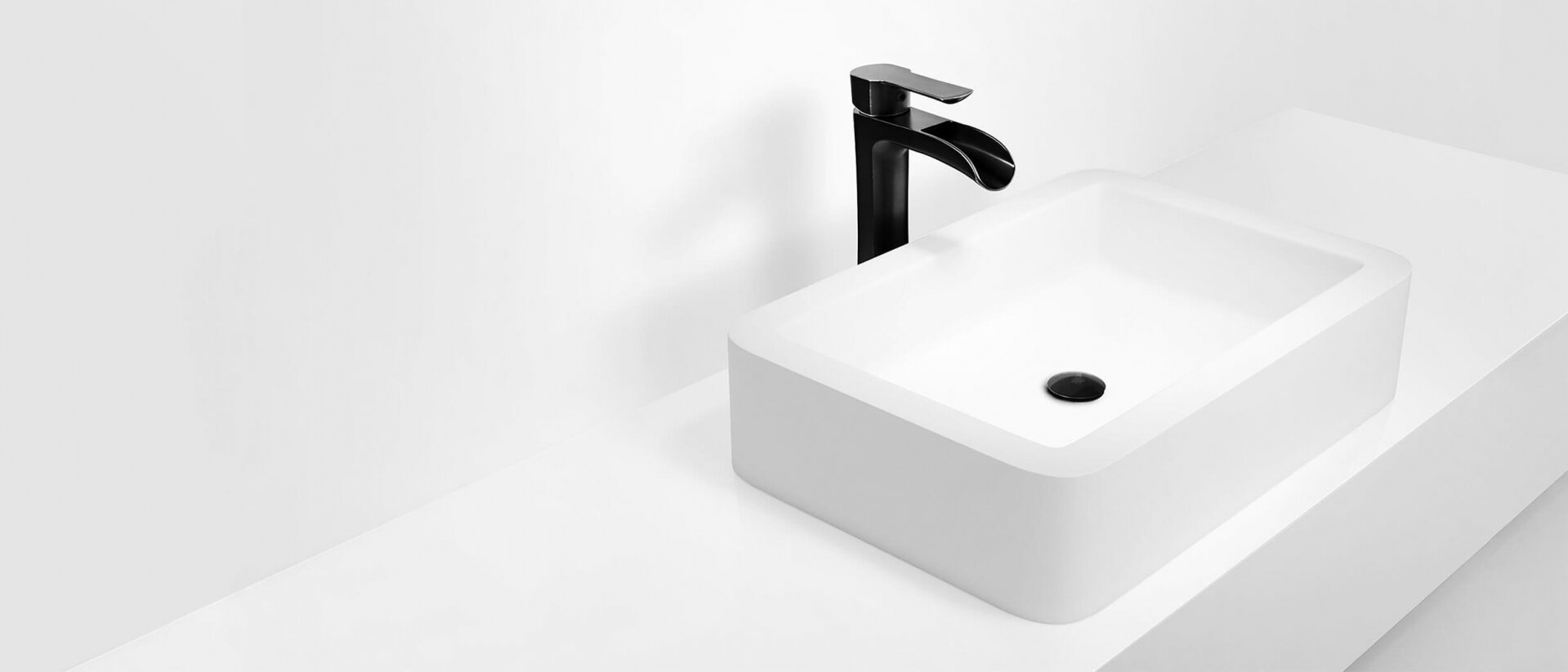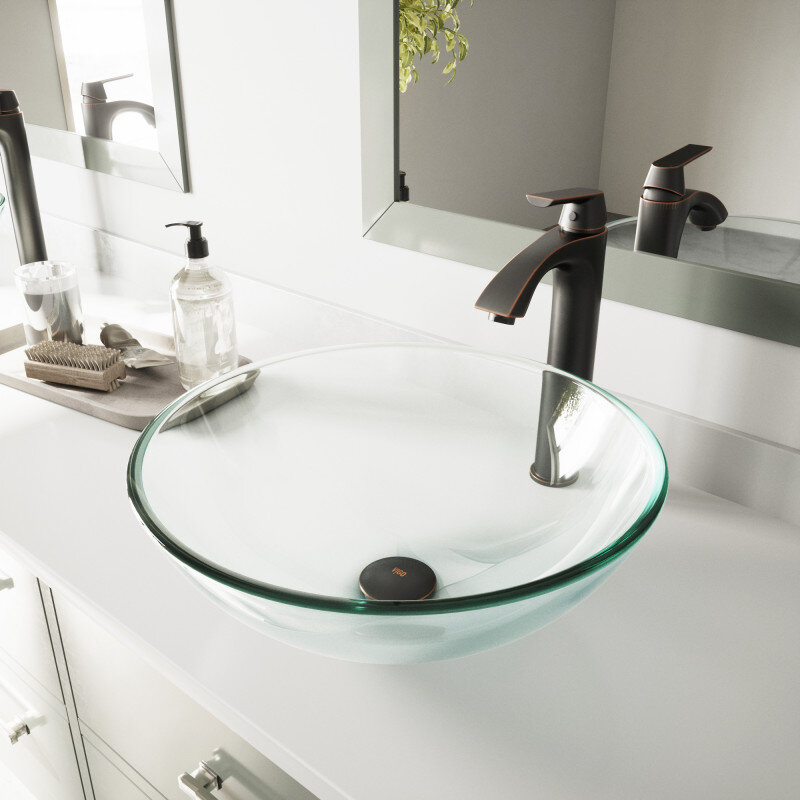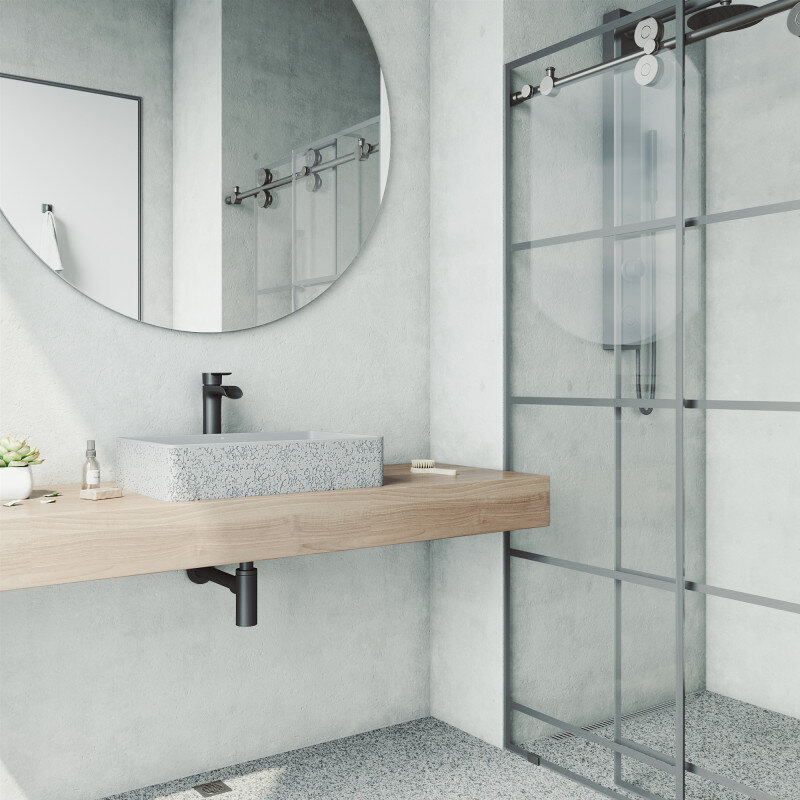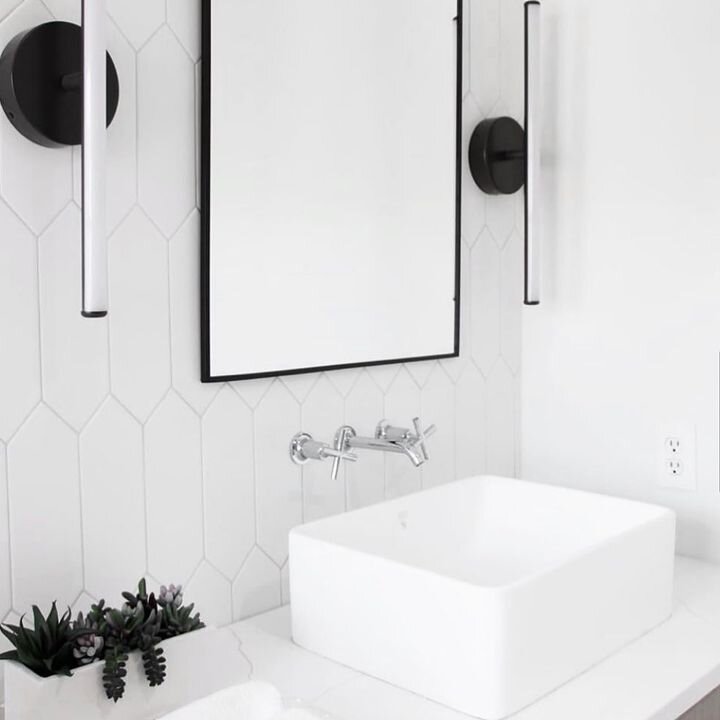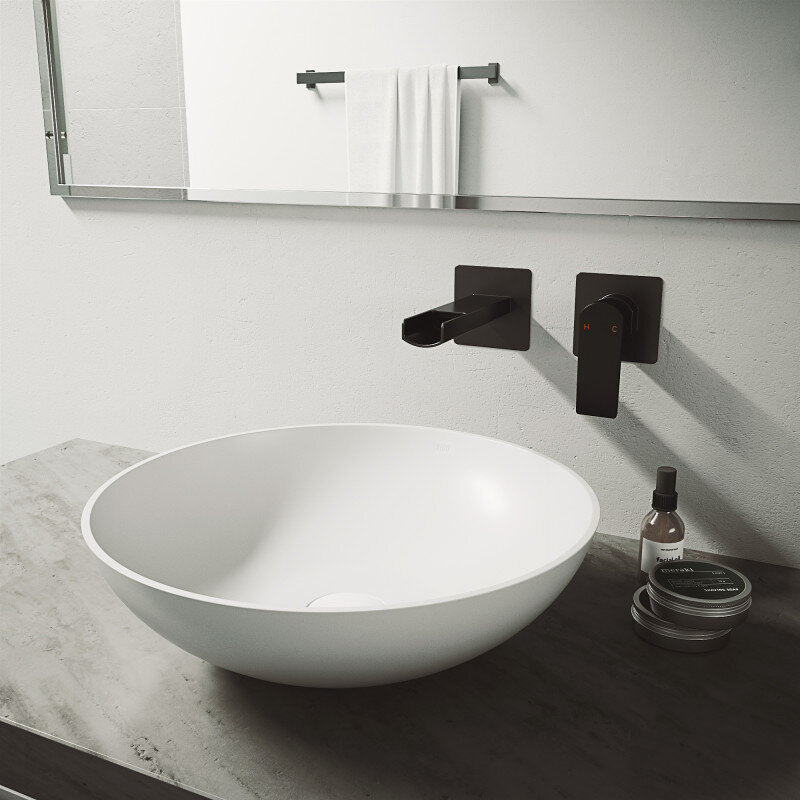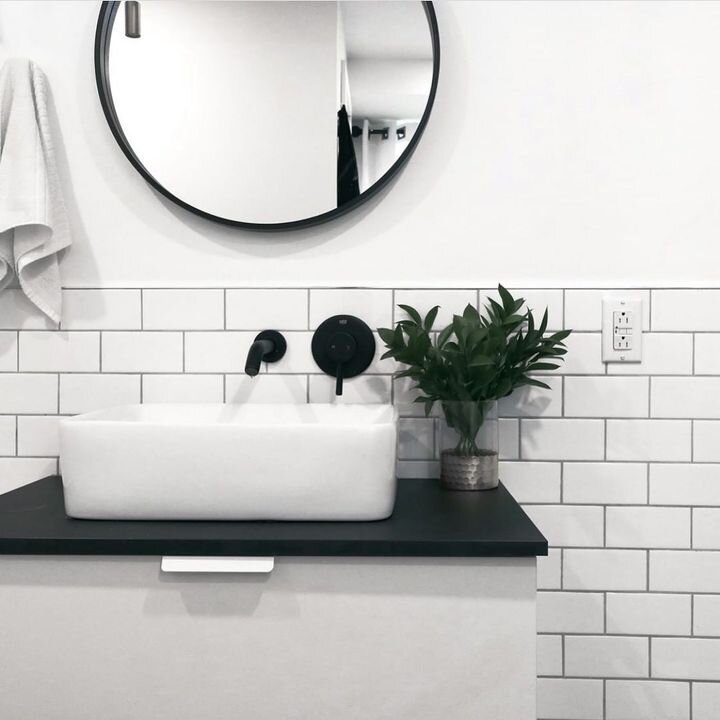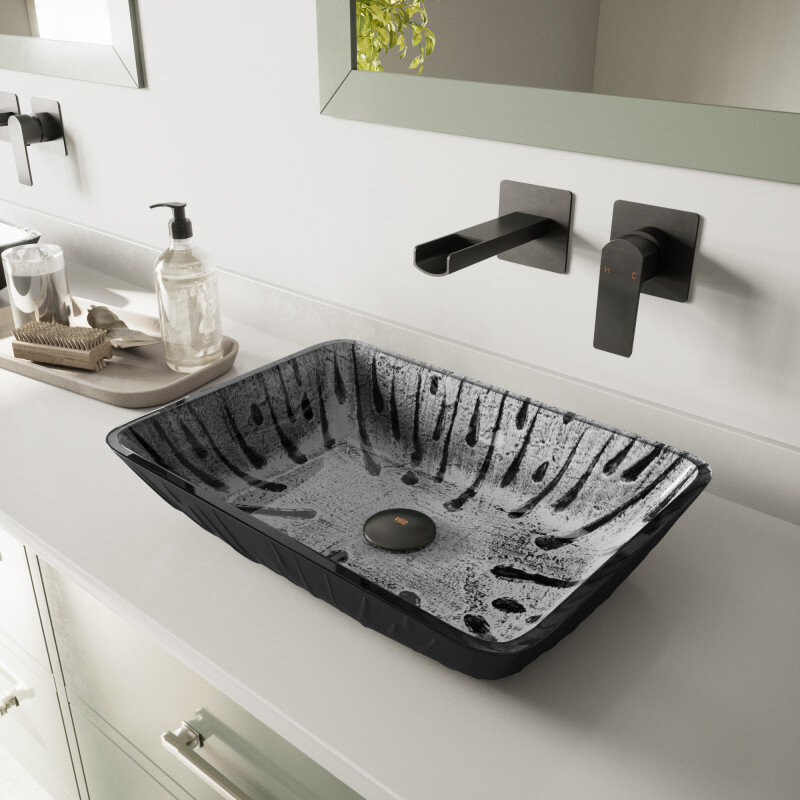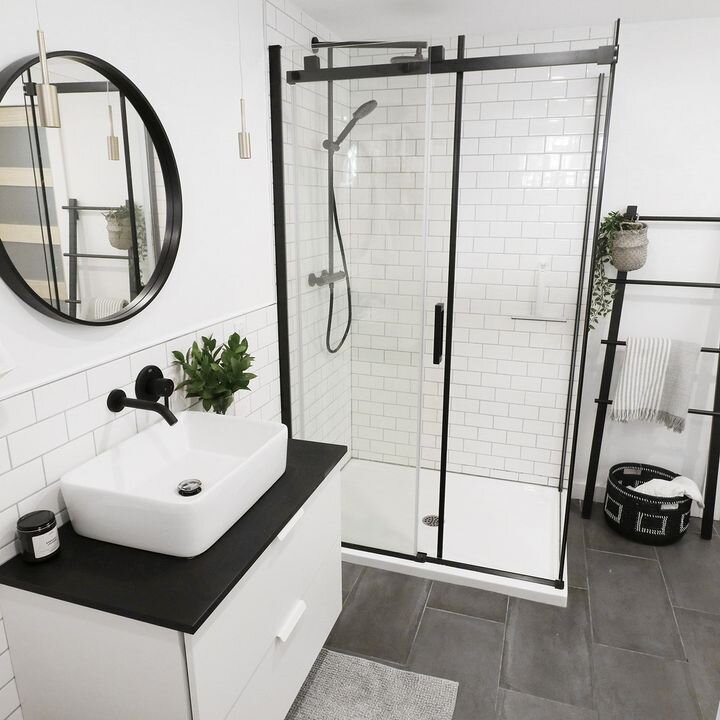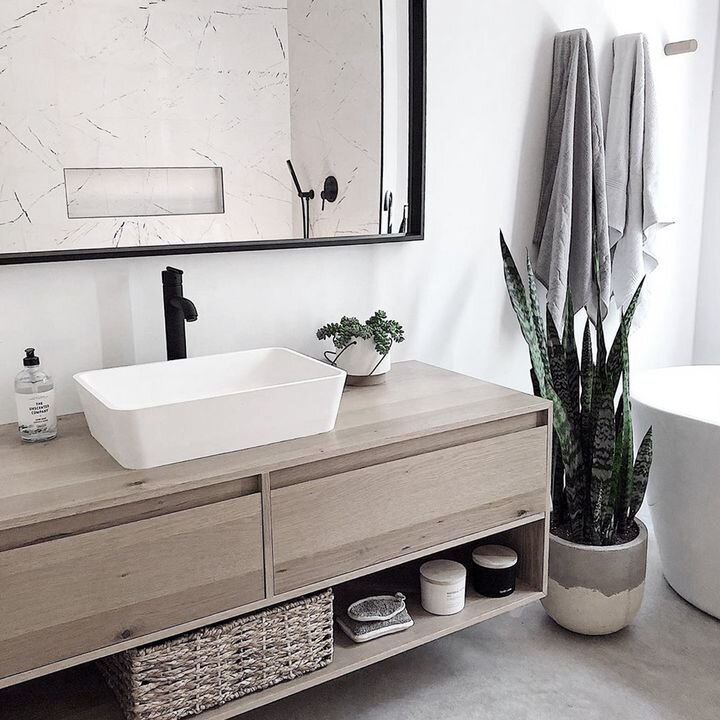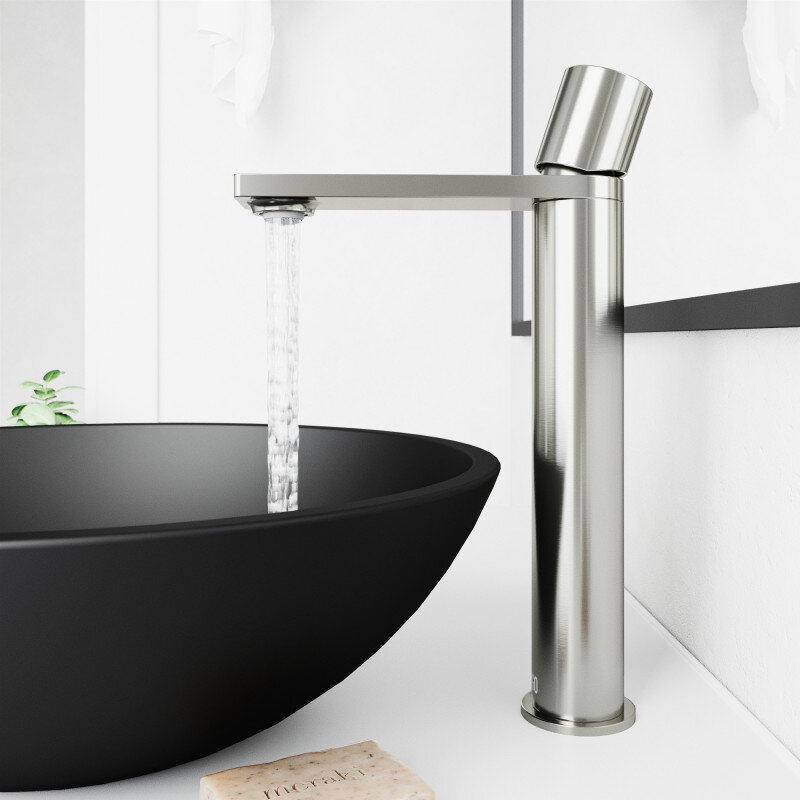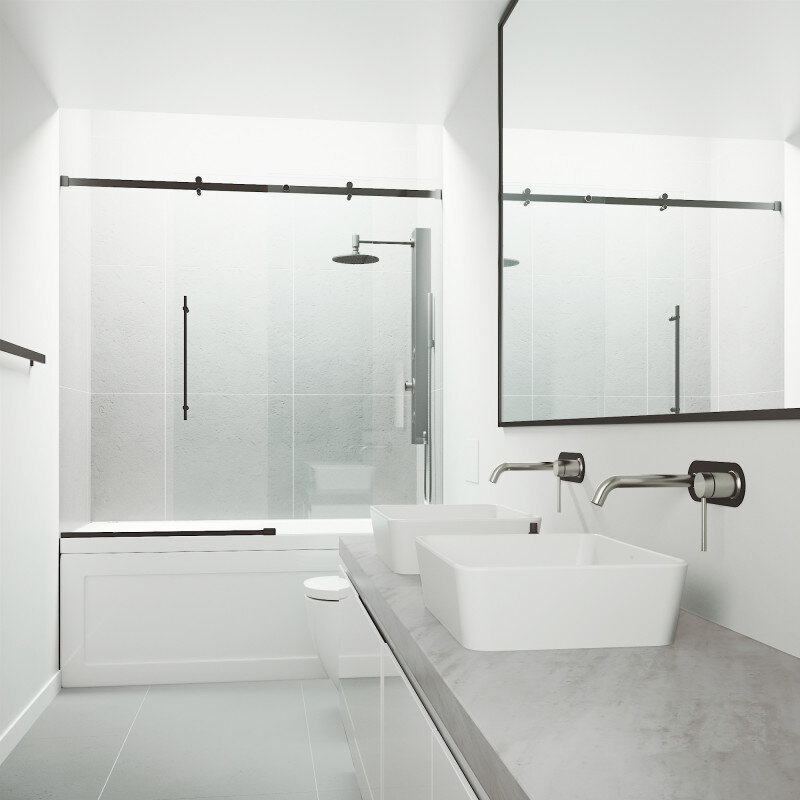LET'S TALK VESSEL SINKS AND WALL MOUNT FAUCETS
Vessel sinks are a stylish variety of bathroom sink that sit on top of the vanity while more traditional sinks are installed under-mount or carved into the vanity or countertop. These beautiful sinks add modern sophistication and appeal with bold curves and stunning contours. Vessel sinks used to come with a sizable price tag, making them more of a high-end luxury item that few could afford. However, their surge in popularity has inspired engineers and manufactures to utilize sophisticated new materials and composites to make this undeniable variety of sinks more available.
Unlike traditional bathroom sinks, vessel sinks come with a unique set of challenges and requirements that should be considered during the planning phase. What are the advantages and disadvantages of choosing a vessel sink? What height should the vanity be? What size single handle faucet do you need to accommodate for a vessel? Keep reading to find the answers to all these questions and much more!
Vessel Sinks - Advantages & Disadvantages
Advantages:
Style: Nothing makes a statement in the bathroom quite like the luxury and gravitas of a vessel sink. Featuring a distinct profile that’s sophisticated, symmetrical, and seamless.
Installation: Installation is easy when you opt for a vessel sink. Since they sit on top of the vanity, you only need to cut one hole for the drain, making it much easier to stay within your budget.
Flexibility: Since vessel sinks sit on top of the vanity instead of being cut into the countertop, it’s much easier to upgrade for future renovations. The versatility of vessel sinks makes them a clear choice for anyone looking to keep costs down and style high.
Space: Vessel sinks allow for a slight increase in space for countertops. Although the sink sticks out, the added space around the vessel creates unique opportunities for pairing décor.
Disadvantages:
Durability: The exposure of vessel sinks leave them much more susceptible to chipping, cracking and damage, particularly around the edge of the basin.
Cleaning: Vessel sinks look great but unfortunately are much more difficult to clean, especially along the bottom rim of the basin where the sink attaches to the countertop. Additionally, because the vessel is exposed, stains and blemishes look much more noticeable than traditional styles of sinks. To make your life a lot easier, give yourself a generous amount of space between the back wall and your vessel to allow for easier, more convenient cleaning.
Stability: A vessel sink isn’t going to be as stable as a traditional inset because it’s fastened in place by a single hole. To add additional stability, you can consider opting for a recesses vessel sink, but we’ll talk more about that later.
Splashing: One of the most common quarrels that people have with vessel sinks is the splashing caused by their wide basin and close proximity to the faucet head. This is another problem that we’ll address later in this article, so stick around.
Overflow: Most vessel sinks do not offer the amenity of an overflow drain and, as a result, water will drain a little slower and is more likely to overflow. Additionally, the open basin makes vessel sinks much more prone to splashing.
Vessel sinks certainly have their own pros and cons. If you’re considering installing one in your own home but you’re worried about some of the shortcomings, then maybe the best place for your vessel sink would be in a low-traffic bathroom or a powder room where it’s less likely to take damage or overflow.
DIFFERENT KINDS OF VESSELS
Vessel sinks are available in a myriad of styles, colors, and materials. Ceramic, glass, stone, copper, marble, wood, and steel just to name a few. Ceramic and glass vessel sinks are by far the most popular and common types. And while each material has its own pros and cons, another undeniable material is stone. VIGO prefers to craft sinks using the sophistication and strength of solid substances. In our opinion, nothing captivates like the structural integrity of our MatteStone™ vessel sinks. Scratch and fade resistant, easy to maintain, and beautiful — you can’t go wrong with a vessel sink by VIGO.
No matter what style you’re going for, you won’t find a more versatile variety of sink than our latest series of vessel bathroom sinks. The most common color for sinks is white, and round vessels have an organic appeal that makes them a popular style of sink. Rectangular styles of sinks are much more modern but they’re quickly becoming a go-to for any designer who’s looking to add something unique to their final layout.
If you’re looking to try something really different, then consider using an unconventional color like black and try pairing it with an asymmetric or unexpected shape to give your bathroom a powerful focal point. Remember to be bold and make a statement with your new sink but remember to choose something that doesn’t clash with your overall aesthetic.
THE CHOICE FOR SMALL BATHROOMS
Vessel sinks are the perfect solution for anyone who’s looking to add some appeal to a boring, generic bathroom. Although it may seem counterintuitive to place a large basin on a small vanity, it’s actually a great way to make a big impact. If you’re trying to make up for limited space, then do something big and bold by installing a stylish vessel sink.
COUNTERTOP TO BOTTOM
Generally, there are two styles of vessel sinks to choose from. An above-counter installation is completely on top of the vanity and the only plumbing necessary is a single drill hole to accommodate for the size of the drain. This is the most common type of installation by far. A recessed sink, on the other hand, sits within the bathroom vanity and requires a bit of inlay work. A larger drain hole is cut to make additional room for the basin, allowing for greater stability.
THE RIGHT COUNTER HEIGHT
THE RIGHT COUNTER HEIGHT
Traditionally when you’re installing a sink, the only height you have to take into consideration is the height of the vanity itself. However, when you’re installing a vessel, you’re going to need to take into account the height of the basin in addition to the surface it’s attached to. You should place your vanity several inches lower to accommodate for this sophisticated style of sink, especially if you have children.
Unfortunately, there’s no definitive rule on vanity height. Taking good measurements is essential when determining the ideal height for your layout and design. While there are standard height ranges you can use for reference, ultimately it will come down to you or your contractor taking precise measurements to find the ideal height for your bathroom.
To calculate the right height for your vessel sink, simply take the height of your vanity and factor in an additional 4-6 inches for the height of your vessel. Standard vanities range from 32-36 inches, so look for something a few inches shorter to accommodate your stylish new vessel.
Of course, with a vessel sink, everything requires a bit of additional planning. Your bathroom mirror, light fixtures, and décor will all need to fit into place, so make sure you plan accordingly before you finalize your installation.
IDEAL FAUCET SIZE & HEIGHT
Perhaps the most important step when you’re considering a vessel sink is the height and placement of your faucet. Purchasing incompatible hardware is a quick way to go over budget, so be sure to measure everything in advance to avoid making costly mistakes. The height and placement of your faucet is essential because the size of your vessel will dictate the location for your other fixtures. If the height of your faucet is too little or too great, then it’s more likely to cause splashing and will require cleanup more frequently. When you’re planning your installation, be sure to leave at least six inches between the spout and the sink.
Here are the two types of faucet that we recommend for vessel sinks:
Vessel Sink Faucets
Vessel sink bathroom faucets are designed specifically for vessel sinks. With a long tapered neck, this special variety of single-hole faucet is tall enough to accommodate the outstretched rim of the basin. If you’re looking for a hassle-free solution, then your best bet is to go with this style of faucet, especially if you choose a vessel sink and faucet combo set. To avoid any measurement mishaps, we recommend purchasing one of these all-in-one kits to simplify the process.
The final placement of the fixture is your decision but we recommend positioning the head of the faucet over the drain or center of your basin. Since the faucet can be placed anywhere around the perimeter of the basin, you need to put careful consideration into where you want to position the faucet relative to the sink and the vanity. To minimize splashing, make sure you take the necessary time to properly plan for your faucet. A variety of hardware finishes can create a perfect accent. VIGO vessel faucets are available in matte black, matte brushed gold, brushed nickel, stainless steel, chrome and oil-rubbed bronze finish.
Wall-Mounted Faucets
Wall-mounted faucets are a great option for anyone who wants to add a stylish finish to their new vessel sink. This style of faucet is mounted to the wall above the sink instead of being mounted on top of the vanity. The same rules for height and placement still apply, but make sure that your plumbing can accommodate this style of faucet before you make a decision that clashes with your design. Also, make sure that the spout of your faucet is positioned over the drain or center of the basin to avoid excessive splashing.
Installing a vessel sink is no easy task, be sure to consult a professional before you start any project that’s outside of your comfort zone.
MINIMIZE SPLASHING
After you’ve found the ideal height and placement for your faucet, another thing you can do to prevent splashing is to adjust your water pressure. If the water pressure is high, your faucet may release water at too high of a rate and volume to avoid unwanted splashing. Using an aerated faucet or waterfall faucet is a good solution for anyone experiencing a water pressure problem. Aerated faucet heads reduce the water pressure by inserting tiny air bubbles into the smooth, flowing stream. This variety of faucet is ideal for vessel style sinks and any basin with a wide opening.
MAINTENANCE & CARE
Because vessel sinks are completely exposed, maintenance and care is essential if you want your vessel sink to withstand the test of time.
Regularly cleaning your vessel is crucial to prevent water stains, spots, and rust. Make it a habit to clean your sink every day. Wiping away water spots every evening is a great way to avoid long-lasting stains. If you make a habit of wiping your sink regularly, then all you need to maintain its pristine condition is a little bit of warm water.
Whenever you need to deep clean your sink, make sure to use forgiving surfaces that won’t scour the material of your vessel. Non-abrasive cloths and buffers are ideal if you want to preserve the façade of your new sink. Vessel sinks are available in a variety of surfaces, so make sure that whatever cleaning solution you use it’s not corrosive to the material of your sink. VIGO’s selection of proprietary vessel sink composites like MatteStone™, CastStone™ and MatteShell™ are known to be resistant against build-up, bacteria, scratches and stains.
As a finishing touch, sealing your vessel sink is a good idea if you want to add one final layer of additional protection.

